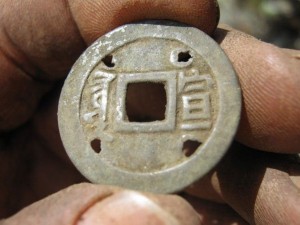Archaeologists doing a heritage impact assessment on the site of a future gold mine northwest of Carmacks, Yukon, have unearthed a Chinese coin from the 17th century. Although old Chinese coins are fairly common finds along the northwest coast of Canada and the United States, this is only the third one ever found in the interior Yukon. It was discovered in July but only announced publicly a couple of days ago after months of fact-checking and research.
According to James Mooney, cultural resource specialist with Ecofor Consulting Limited, the archaeological firm hired by Western Copper and Gold Corporation to do the heritage impact assessment, all three of the Yukon Chinese coins were found in an archaeological setting. No later historical materials were found along with them, indicating that the coins were traded into the interior before the Klondike Gold Rush via the First Nations coastal trade with Europeans rather than by Europeans traipsing into the interior themselves.
 The Chinese characters mark the coin as one minted during the reign of Emperor Kangxi of the Qing Dynasty. He was the longest-reigning Chinese emperor in history, ruling from 1662 to 1722, but this particular coin was minted between 1667 and 1671. We know this because it is number six in a series of coins known as “poem coins” minted by Kangxi who was famous for his poetry. There were 20 different “poem coins” minted over the years. If placed in a certain order, the characters on each coin form a poem. The coins were considered good luck charms and once people collected all 20 in the series, they often wore them on a chain for good luck.
The Chinese characters mark the coin as one minted during the reign of Emperor Kangxi of the Qing Dynasty. He was the longest-reigning Chinese emperor in history, ruling from 1662 to 1722, but this particular coin was minted between 1667 and 1671. We know this because it is number six in a series of coins known as “poem coins” minted by Kangxi who was famous for his poetry. There were 20 different “poem coins” minted over the years. If placed in a certain order, the characters on each coin form a poem. The coins were considered good luck charms and once people collected all 20 in the series, they often wore them on a chain for good luck.
In addition to the Chinese characters and a square hole in the middle, the coin also has four small holes poked along the edge across from each corner of the square hole. The extra holes could have been made in China or by the First Nations in Canada. A Chinese tradition held that coins nailed to gates and doorways brought good luck, and First Nations were known to attach coins to their clothes as decoration or to create a kind of rudimentary plate armor out of a network of overlapping coins.
The area where the coin was discovered was a promontory overlooking a river on the ancient Dyea to Fort Selkirk trade route. It would have made a good camping spot for a traveler following the trade route. The first written accounts of European traders, mainly Russian fur traders, doing business in northwest Canada date from mid-1700s, although there is evidence of earlier trade, perhaps even as early as the 15th century. The Russian traders exchanged goods like silk, weapons, tobacco, clothing for sea otter, seal, beaver pelts with the coastal Tlingit peoples. The Russians would then trade the furs with the Chinese.
The Tlingit had the monopoly on direct trade with the Russians. They controlled the Chilkoot Pass through the mountains to the interior regions and they would trade coastal goods and European goods for copper and fur with the Yukon First Nations.
Given the importance of this discovery, Ecofor is recommending that the road Western Copper and Gold planned to built where the coin was found be built elsewhere so the site can continue to be studied.